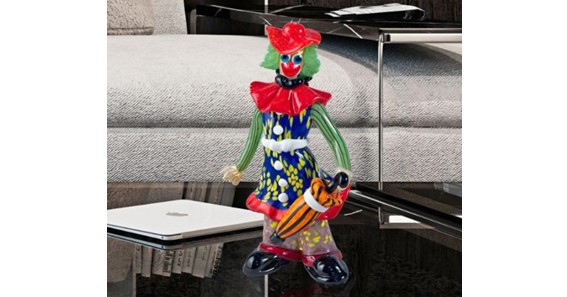The tradition of glassmaking in Murano, a small island near Venice, Italy, dates back to the 13th century. Glassmakers in Murano have been creating beautiful and intricate pieces of glass art for centuries, including vases, chandeliers, jewelry, and sculptures.
One of the most popular forms of Murano glass art is the clown. Murano glass clowns are known for their vibrant colors, intricate details, and playful expressions. They are a favorite among collectors and art enthusiasts, and are often displayed in homes, offices, and galleries around the world.
The creation of Murano glass clowns requires a combination of technical skill and artistic talent. Glassmakers in Murano undergo years of apprenticeship and training to learn the complex techniques of glassmaking, and the creation of a Murano glass clown requires a high level of skill and precision.
A Murano glass clown is a beautiful and unique piece of art that is created through a complex and labor-intensive process. The creation of a Murano glass clown involves the use of various traditional glass-making techniques that have been developed and refined over centuries by skilled Murano glass artisans.
The first step in creating a Murano glass clown is to gather the materials needed to make the glass. The raw materials used in Murano glassmaking include sand, soda ash, limestone, and various metallic oxides, which are melted together in a furnace at temperatures exceeding 1500 degrees Celsius. Once the glass is melted and at the right consistency, the glassmaker will use a long metal rod to scoop up a ball of molten glass from the furnace and transfer it to the workbench.
The glassmaker will then use a variety of techniques to shape the glass into the desired form of the clown. This may involve using heat to soften the glass, blowing into the glass with a metal tube to create air pockets and expand the shape, and using a variety of tools to shape and manipulate the glass into the desired form.
Once the basic form of the clown has been created, the glassmaker will add details to the piece. This may involve using different colors of glass to create the clown’s face, hat, and clothing. The glassmaker may also add intricate details to the piece using a variety of traditional glassworking techniques, such as filigree, murrine, or ribbing.
The final step in creating a Murano glass clown is to anneal the piece. Annealing involves slowly cooling the glass over a period of several hours in a special oven called a lehr. This process helps to ensure that the glass cools evenly and does not crack or break.
Once the piece has been annealed, it is inspected for any imperfections or flaws. If any flaws are found, the piece may be discarded or recycled. However, if the piece is deemed to be of high quality, it will be polished and finished by the glassmaker, and may be signed or stamped with the Murano glassmaker’s trademark to indicate its authenticity.
In conclusion, the creation of a Murano glass clown is a complex and multi-step process that requires a high level of skill and expertise. From gathering the raw materials to shaping and finishing the glass, Murano glass clowns are a testament to the skill and artistry of the Murano glassmaking tradition.
